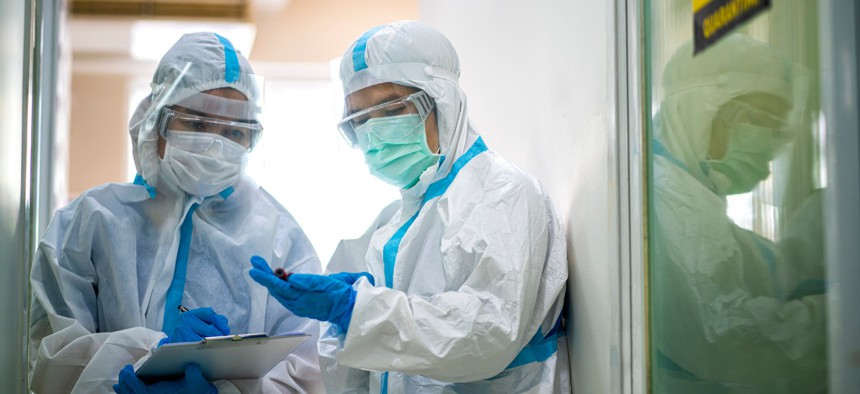
tuachanwatthanna / istock
Preparing for the Next Pandemic
Three challenges stand out as testing our nation’s ability to counter emerging biological threats.
The past year has been both a devastating and illuminating experience for those responsible for protecting the United States from biological threats. With its significant toll on millions of lives, the national and global economy and national security, COVID-19 has been a wake-up call to how fragile our systems are and has tested our national response teams with its historic challenges.
The Johns Hopkins Applied Physics Laboratory was called to the national response in the early weeks of COVID-19, collaborating with our university partners on the newly created Johns Hopkins Covid Dashboard, which emerged as the global tool for maintaining situational awareness. Our government sponsors then invited us to support FEMA’s National Response Coordination Center and Health and Human Services’ Data Strategy and Execution Workgroup, where we have enabled rapid analyses for decision-making in operations, and integrated data from many state and local governments and foreign countries. We have responded to a range of requests for applied science research from across the government.
Three challenges stand out as testing our nation’s ability to counter emerging biological threats. First, we lack understanding of the fundamental characteristics of biological systems. In physics, we talk about first principles: whether we know the details of a threat or not, we can usually rely on the laws of physics to help bound the problem. When it comes to biology, we don’t have a first-principles understanding of all the aspects we need to predict or even understand what we might be facing, nor the tools to understand how the dynamics of biology, environment and individual behavior affect each other.
The genome of the novel coronavirus was sequenced within weeks of reported cases, yet that provided little insight into how deadly it was, how transmissible it was, how it attacked our bodies, etc. To this day, after more than 165 million cases and 3.4 million deaths worldwide, we still cannot answer fundamental questions: Why are so many people asymptomatic while others quickly succumb to the disease? And why are there so many different expressions of the disease as the virus itself remained relatively stable?
Second, we lacked the data collection infrastructure, standards, and reporting mechanisms to enable rapid situational awareness and prediction at the start of the pandemic. Differences in what data was reported across jurisdictions nationally and globally made it very difficult to present an accurate picture of what was going on. This deficiency is now beginning to be addressed, but we need to think about what we need in the future and work to build systems that deliver true awareness and preparedness.
Third, we suffer from brittleness of our healthcare infrastructure and supply chains. The fact that we don’t have an integrated healthcare “system” but rather thousands of individual systems was a huge challenge as some hospitals were being overrun while others were empty. At the state level, there was no way to look across all the hospitals and adjust loads appropriately. Heightening the challenge, the United States’ dependence on China and India for pharmaceuticals and personal protective equipment has been known for years, but it wasn’t until COVID-19 that we acutely felt those repercussions. At the most granular level, clinicians were treating patients and learning effective protocols, yet there was no mechanism to aggregate, validate, and broadly disseminate these real-world, real-time, lessons.
So what can we do to overcome these challenges? First, our science, public health and healthcare sectors need dedicated and sustained funding for research in the biological sciences. And we need a strategy for it, to focus research on key topics such as linking genotype to phenotype and understanding how and why similar chemical and molecular interactions in different people result in different outcomes. We must form a first-principles understanding of the underpinning of these biological systems to prevent such devastating impacts in the future.
Second, the U.S. government and national organizations together must strengthen partnerships at the federal, state, and local level to establish standards and reporting requirements for what data must be reported and in what format, and to develop more robust capabilities to integrate data for effective situational awareness.
Third, healthcare-system resilience requires a systems approach: we need new models of how essential entities interact and are interconnected. We require a health data ecosystem that spans global to individual levels and disseminates data and knowledge where it’s needed, when it’s needed and to whom. Federal and state health officials and healthcare providers need the ability to assess situational awareness such as to identify and present a picture of hospital capacity utilizing aggregated data and system models to avoid crises.
Lastly, to secure our nation from biological threats, it is critical that we take a more holistic and rigorous approach to preparing for and mitigating potential biological threats that may threaten our national security and ensure we are prepared. In the global COVID-19 response, it has been inspiring to see how thousands of organizations across industry, academia and government have come together to solve shared problems. We need to maintain and grow these partnerships, nationally and globally, and leverage all the capabilities available to ensure we respond far better and faster next time.
Sezin A. Palmer is the first mission area executive for national health at the Johns Hopkins University Applied Physics Laboratory. The vision of the National Health Mission Area is to revolutionize health through science and engineering through a systems approach to understanding health determinants to better predict and prevent illness, injury and disease and applying this knowledge to develop novel capabilities to rapidly detect and respond to changes in health status.






